January
2024
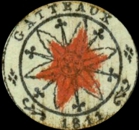 |
Coming from the
Dudley Ollis collection which is auctioned in several parts at Dominic
Winter, all the
decks arrived early this month, so this time the choice was easy. This
deck was the most interesting in a lot of 3 French patterned decks and
the main reason to participate in the live auction. So
here is the first deck that was designed by Gatteaux.
|
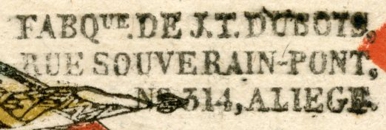
|
This
version of the deck has always intrigued me. The dots to establish ranking, the
single images with double sided dots and pips and the unusual names of the
queens and jacks were the most intriguing ones, but also the appearance of the
dog on the Jack of Spades. He is a feature that has been repeated in
the later standard single image French pattern, also designed by Gatteaux.
A
short history: after
Napoleon Bonaparte had taken power in France in 1799 and had declared himself
emperor in 1804, he commissioned the Neoclassical painter Jacques-Louis David to
design a new French pattern in 1810. However, his classical designs were not
received well by the public and dismissed by Napoleon, who now commissioned Nicolas-Marie Gatteaux. The
sculptor, who lived in Paris from his birth on 2 August 1751 until his death on
24 June 1832, had become famous for his engraving of special medals and had been
appointed "graveur des médailles du Roi" in 1781. He based
his designs on the neoclassical style by David. Neoclassicism was in vogue in
those days. Gatteaux presented his designs in his
"Empire" deck in 1811.
The
illustrations above show the Gatteaux name and date, which can be found on the
shield on the jack of clubs, and the over-stamp with the name of the publisher,
which can be found on the jack of hearts. The Fabrique de J.T. Dubois was
located at the Rue Souverain-Pont 314 in Liège (Belgium). Although there are
wrappers of other decks, on which J.T. Dubois presents his company as "manufacteur"
(maker), I doubt that in this case J.T. Dubois printed the sheets. In his
description Dudley Ollis already wrote about J.T. Dubois "but they could well be simply the
colourer of the printed sheet" and I agree with him. I don't know how easy
or difficult it was for a Belgian manufacturer to obtain official French playing
card paper, but the cards from the deck all have the eagle watermark. So I tend
to rather regard J.T. Dubois as the publisher.
According to the WWPCM site there were 3 generations of Dubois active in Liège,
of which this J.T. Dubois between c1800 -1825. His was first located on nr. 314
and later on nr. 83 in the same street.
In
the Gatteaux deck the courts are all named in full, in French and in the same
type font. In the deck by J-L David only the kings were named and their names
printed in the language that they spoke. So king David's name was printed in Hebrew
and Alexander's in Greek. That must have been one of the reasons that the public
didn't like the deck. Gatteaux named his queens and jacks after figures, related
to the king in each suit. In the later standard French pattern all the kings
have kept their names and their suits, but the names of all the queens and
jacks, except for Ogier (renamed as Hogier), have been changed. Noticeable in
this Gatteaux deck is that the names of the kings are all printed on the right
and those of the queens and jacks on the left.
|
In the spades suit King David is accompanied by his second wife Abigaïl and
Azael (a.k.a. Azazel) is seen as a demon in the Hebrew culture, however here
represented as a hunter.
Which brings me to something completely different: the question of the dog. Was it
Gatteaux who introduced it?
Click the Jack to see some versions by other
publishers and the
answer to the question. |
|

|
 |
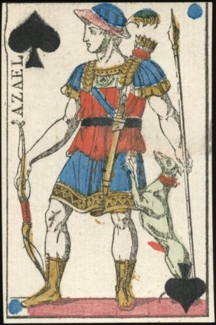
|
|
|
|

|
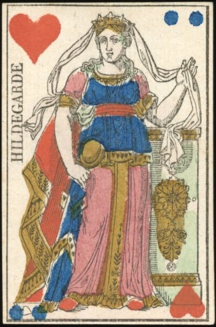
|
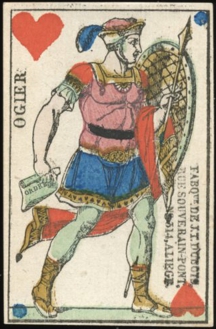
|
|
Hildegarde was a
Frankish queen consort, the second wife of Charles. |
|
Charles
(I), king of the Franks,
better known as Charlemagne. |
|
Ogier
(the Dane) is a legendary paladin of Charles. |
Their old age doesn't make them less dull.......
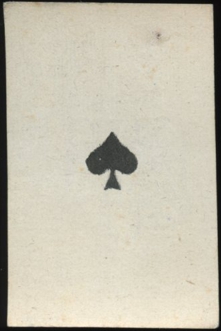
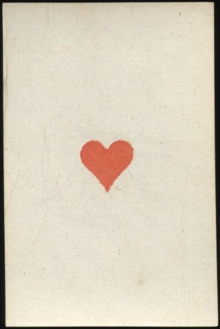


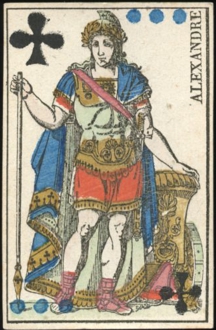 |
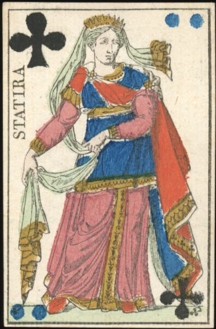 |
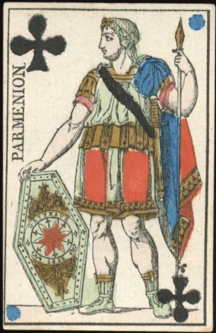 |
| Statira
was his wife. |
| Alexander (the Great) |
|
Parmenion, a general in his army. |
|
|
|
| (Gaius
Julius) Caesar. |
|
Curion (Caius Scribonius Curio) was a political friend of Caesar. |
|

|
Calpurnie
(Calpurnia), his third or fourth wife. |
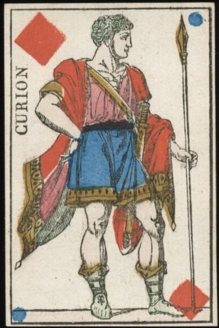
He also lead the invasion of Africa.
|
 |
 |
The deck has 52 cards
with a blank back. |

|
|
Dudley Ollis,
the auction house and the Britsh Museum dated the deck as 1811. Of course
that year is mentioned on the shield, so the date should be obvious.
However, when you've seen the different versions, which I show with the
comparison of the jacks, there's a development, ending in the double pips
and dots. So I tend to date the actual publication of this specific deck in a later year: c1815?
|
|
On
March 4 there was a post in the Pre-1950 group on Facebook with a
reference in a newspaper ad from 1813 to the J.J. Dubois playing cards
factory in 's Hertogenbosch, Netherlands. From 1806 until 1814 the
factory of J.J. Dubois was officially moved from Luik (Liège) in
Belgium to 's Hertogenbosch in the Netherlands for playing card tax
reasons. These were lower in the Kingdom of the (Northern) Netherlands.
In 1814 the Southern Netherlands (Belgium) were de facto united with the
Northern Netherlands and this was made official in 1815. So the rates
for playing card taxes were then the same and Dubois returned to Liège.
This would confirm the dating of c1815 for this deck. |
BACK
TO PRESENT MONTH



















